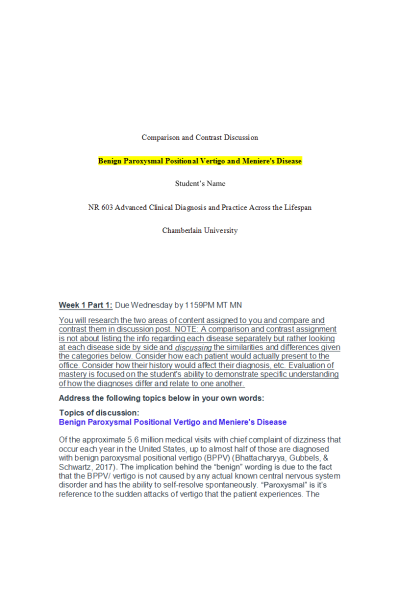NR 603 Week 1 Compare and Contrast Discussion; Benign Positional Vertigo and Meniere’s Disease
-
$15.00
| Institution | NR 603 Advanced Clinical Diagnosis and Practice Across the Lifespan |
| Contributor | Sharonda |
Week 1 Part 1:
You will research the two areas of content assigned to you and compare and contrast them in discussion post. NOTE: A comparison and contrast assignment is not about listing the info regarding each disease separately but rather looking at each disease side by side and discussing the similarities and differences given the categories below. Consider how each patient would actually present to the office. Consider how their history would affect their diagnosis, etc. Evaluation of mastery is focused on the student's ability to demonstrate specific understanding of how the diagnoses differ and relate to one another.
Address the following topic below in your own words:
Topics of discussion:
Benign Paroxysmal Positional Vertigo and Meniere's Disease
Of the approximate 5.6 million medical visits with chief complaint of dizziness that occur each year in the United States, up to almost half of those are diagnosed with benign paroxysmal positional vertigo (BPPV) (Bhattacharyya, Gubbels, & Schwartz, 2017). The implication behind the “benign” wording is due to the fact that the BPPV/ vertigo is not caused by any actual known central nervous system disorder and has the ability to self-resolve spontaneously. “Paroxysmal” is it’s reference to the sudden attacks of vertigo that the patient experiences. The patient’s sense of personal or environmental movement despite lack of actual movement constitutes the definition of vertigo (Bhattacharyya et al., 2017).
This positional vertigo is directly related to gravity whereas alternative forms are related to central or vascular origin.
Despite its benign status and primarily positive outcomes, it still has the ability to affect a patient’s daily quality of life significantly, particularly when the condition goes undiagnosed and untreated for an extended period of time. Of particular concern is the patient’s increased risk for falls, significant impact on completion of activities of daily living, associated depression, and loss of work days- to include leaving their current job. The longer that an older patient goes undiagnosed, the more likely they are to be considered a burden to their family and risk being placed into a nursing home. Additionally, there are two forms of BPPV, which affects the posterior or lateral semicircular canals. The posterior form of BPPV is the most common, affecting more than 85% of BPPV patients (Bhattacharyya et al., 2017).
End of document preview
| Instituition / Term | |
| Term | Fall Semester |
| Institution | NR 603 Advanced Clinical Diagnosis and Practice Across the Lifespan |
| Contributor | Sharonda |



















